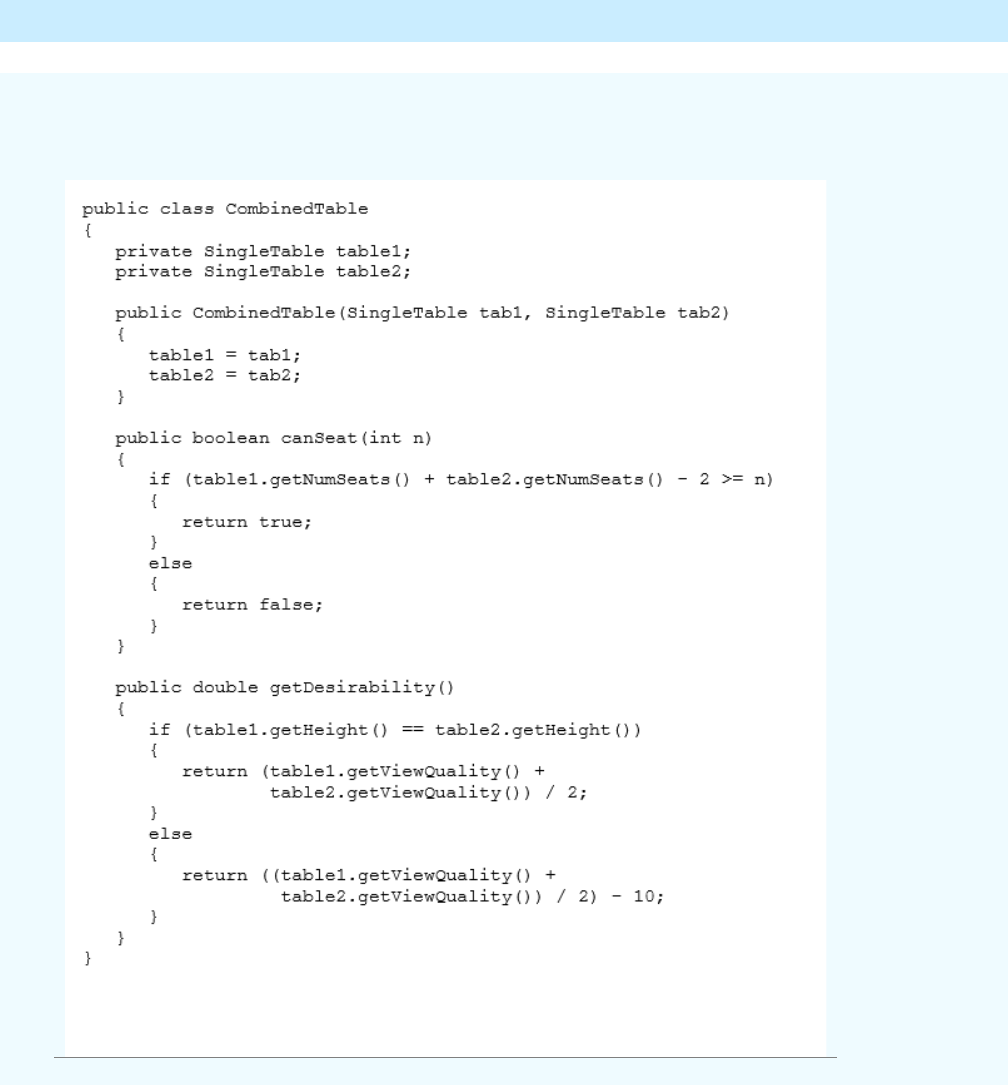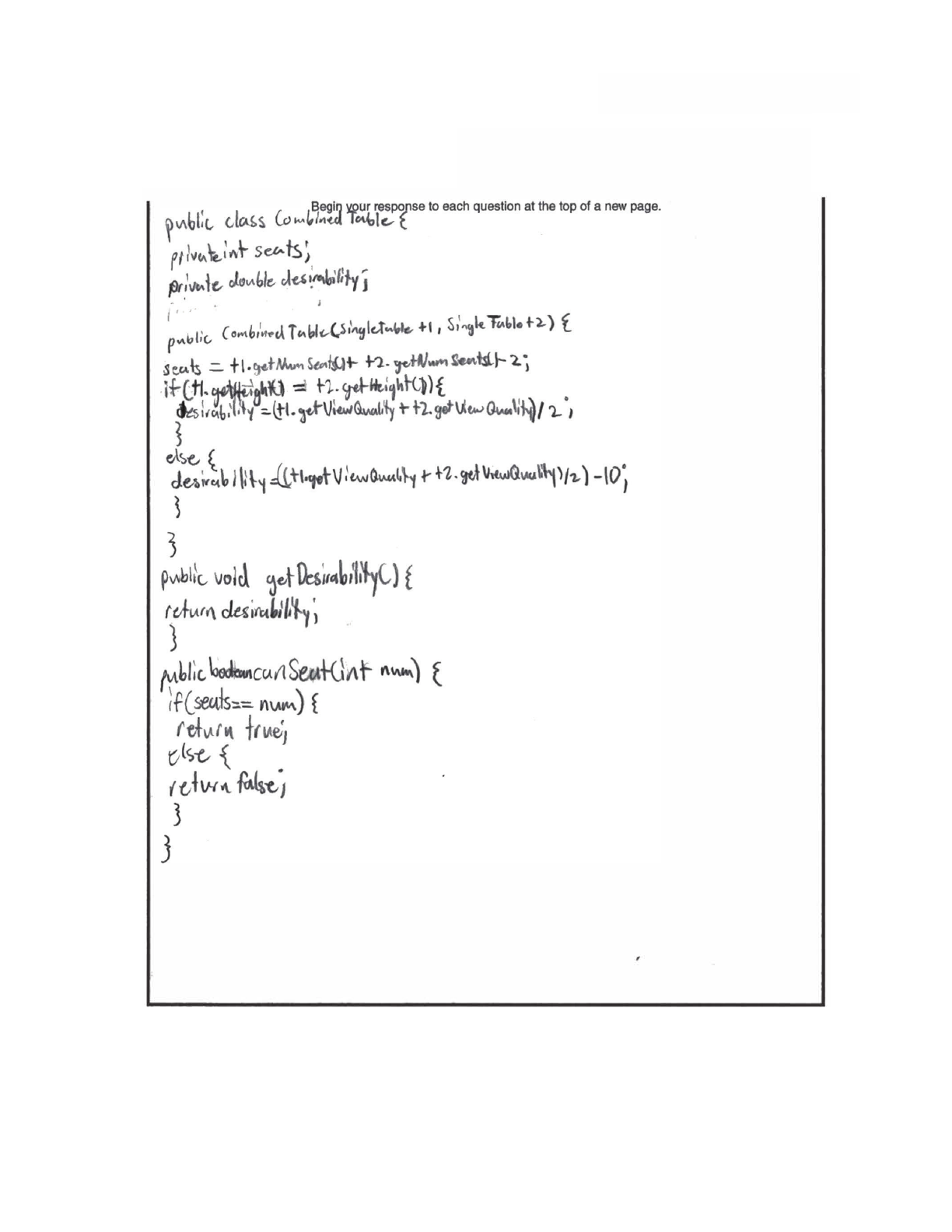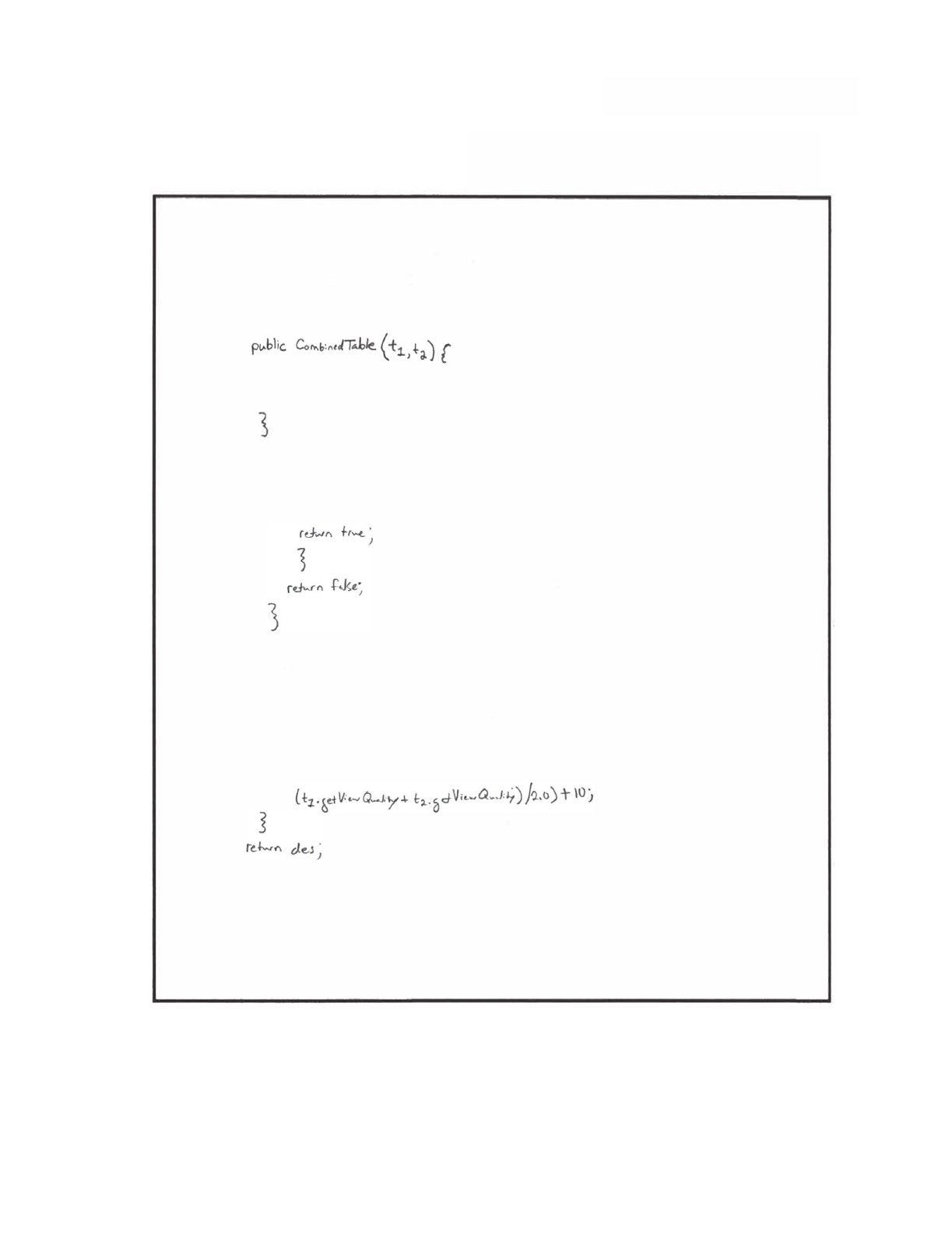
2021
AP
®
Computer Science A
Sample Student Responses
and Scoring Commentary
Inside:
Free Response Question 2
•• Scoring Guideline
•• Student Samples
•• Scoring Commentary
© 2021 College Board. College Board, Advanced Placement, AP, AP Central, and the acorn logo are registered
trademarks of College Board. Visit College Board on the web: collegeboard.org.
AP Central is the ocial online home for the AP Program: apcentral.collegeboard.org.

AP® Computer Science A 2021 Scoring Guidelines
© 2021 College Board
Applying the Scoring Criteria
Apply the question scoring criteria first, which always takes precedence. Penalty points can only be deducted
in a part of the question that has earned credit via the question rubric. No part of a question (a, b, c) may
have a negative point total. A given penalty can be assessed only once for a question, even if it occurs
multiple times or in multiple parts of that question. A maximum of 3 penalty points may be assessed per
question.
1-Point Penalty
v) Array/collection access confusion ([] get)
w) Extraneous code that causes side-effect (e.g.
, printing to output, incorrect precondition check)
x) Local variables used but none declared
y) Destruction of persistent data (e.g., changing value referenced by parameter)
z) Void method or constructor that returns a value
No Penalty
• Extraneous code with no side-effect (e.g., valid precondition check, no-op)
• Spelling/case discrepancies where there is no ambiguity*
• Local variable no
t declared provided other variables are declared in some part
• private or public qualifier on a local variable
• Missing public qualifier on class or constructor header
• Keyword used as an identifier
• Common mathematical symbols used for operators (× • ÷ ≤ ≥ <> ≠)
• [] vs. () vs. <>
• = inst
ead of == and vice versa
• length/size confusio
n for array, String, List, or ArrayList; with or without ( )
• Extraneous [] when referencing entire array
• [i,j] inste
ad of [i][j]
• Extraneous size in array declaration, e.g., int[size] nums = new int[size];
• Missing ; where structure clearly conveys intent
• Missing { } where indentation clearly conveys intent
• Missing ( ) on
parameter-less method or constructor invocations
• Missing ( ) ar
ound if or while conditions
*
Spelling and case discrepancies for identifiers fall under the “No Penalty” category only if the correction can
be unam biguously inferred from context, for example, “ArayList” instead of “ArrayList”. As
a
counterexample, note that if the code declares "int G=99, g=0;", then uses "while (G < 10)"
instead of "while (g < 10)", the context does not allow for the reader to assume the use of the lower
case variable.

AP® Computer Science A 2021 Scoring Guidelines
© 2021 College Board
Question 2: Class Design 9 points
Canonical solution
9 points

AP® Computer Science A 2021 Scoring Guidelines
© 2021 College Board
CombinedTable
Scoring Criteria Decision Rules
1 Declares class header:
class CombinedTable
and constructor header:
CombinedTable(SingleTable ___,
SingleTable ___)
(must not be private)
Responses can still earn the point even if
they declare the class header as class
CombinedTable extends
SingleTable
1 point
2 Declares appropriate private instance
variables including at least two
SingleTable references
Responses can still earn the point even if
they declare an additional instance
variable to cache the number of seats at
the combined table
Responses will not earn the point if they
• declare and initialize local variables in
the
constructor instead of instance
variables
• declare additional inst
ance variable(s)
that cache the desirability rating
• omit keyword private
• declare variables outside the class
1 point
3 Constructor initializes instance variables using
parameters
Responses can still earn the point even if
they declare and initialize local variables
in the constructor instead of instance
variables
1 point
4 Declares header: public boolean
canSeat(int
___)
1 point
5 Calls getNumSeats on a SingleTable
object
Responses can still earn the point even if
they call getNumSeats on constructor
parameters or local variables of type
SingleTable in the constructor
Responses will not earn the point if they
call the SingleTable accessor
method on something other than a
SingleTable object
1 point
6 canSeat(n) returns true if and only if
sum of seats of two tables - 2 >= n
Responses can still earn the point even if
they call getNumSeats incorrectly
1 point
7
Declares header: public double
getDesirability()
1 point
8
Calls getHeight and
getViewQuality on SingleTable
objects
Responses can still earn the point even if
they call getHeight or
getViewQuality on constructor
parameters or local variables of type
SingleTable in the constructor
1 point

AP® Computer Science A 2021 Scoring Guidelines
© 2021 College Board
Responses will not earn the point if they
call the SingleTable accessor
methods on something other than a
SingleTable object
9 getDesirability computes average of
constituent tables’ view desirabilities
Responses can still earn the point even if
they
• call getHeight or
getViewQuality on
constructor
parameters or local variables of type
SingleTable in the constructor
• fail to return the computed average
(re
turn is not assessed)
Responses will not earn the point if they
• fail to have an if st
atement and a
correct calculation
• choose t
he incorrect value (average
vs. average – 10) based on evaluation
of the if statement condition
1 point
Question-specific penalties
None
Total for question 2 9 points

Q2 Sample A
1 of 1

Q2 Sample B
1 of 1

Q2 Sample C
1 of 1
AP
®
Computer Science A 2021 Scoring Commentary
© 2021 College Board.
Visit College Board on the web: collegeboard.org.
Question 2
Overview
This question tested the student’s ability to:
• Write program code to define a new type by creating a class.
• W
rite program code to create objects of a class and call methods.
• Write program code to satisfy methods using expressions and conditional statements.
Stu
dents were asked to design the class CombinedTable, which represents a table composed of two single
tables pushed together. The students were given a partial definition of the class SingleTable, which
represents a table at a restaurant, to be used in their CombinedTable class design. Students were expected to
demonstrate an understanding of class constructor and method header syntax. Additionally, students were
expected to determine the data types and instance variables needed to track the information shown in the
example. Students were then expected to correctly declare, initialize, access, and generate the appropriate values
from their data members. Students were expected to properly protect the data members by declaring them as
private and properly define the methods canSeat and getDesirability. Students had to recognize that
they could not compute and store the desirability value in the constructor because the design of SingleTable
allowed for a table view quality to change at any time; getDesirability always had to reflect the latest
values of the SingleTable view quality.
Sample: 2A
Score: 9
Point 1 was earned because the response correctly declares the class header and constructor header. The
response correctly names the constructor and provides two SingleTable parameters. Both the class and the
constructor are declared as public. Point 2 was earned because the response declares two SingleTable
instance variables. The view quality of a constituent table may change after a CombinedTable is
constructed. The point verifies that the design of the response supports this by requiring SingleTable
instance variables. The instance variables must be declared as private. Point 3 was earned because the
constructor initializes the instance variables with parameter values. The point tests not only the assignment of
a parameter to an instance (or local) variable but also that the assignment involves consistent types. Point 3
does not assess the usefulness of the values assigned. Point 4 was earned because the response correctly
declares the header for the canSeat method. The method must return a boolean, take a single int
parameter, and have a public access specifier. Point 5 was earned because the response calls the
getNumSeats method on SingleTable objects. The response calls the method correctly with instance
variables a and b. In the response, the call to getNumSeats occurs in the canSeat method. Point 6 was
earned because the response chooses the correct return value, based on the correct comparison, with a correct
seat calculation. The point evaluates the logic of the canSeat method. To earn the point, both the calculation
of available seats and the returned value must be correct. Point 7 was earned because the header for the
getDesirability method is correct. To earn the point, the method must be declared as public, must
have a return type of double, and must have an empty parameter list. Point 8 was earned because the
response correctly calls both the getHeight and getViewQuality methods on SingleTable objects.
The response calls both methods on SingleTable instance variables in the getDesirability method.
The missing () on the parameter-less method invocation (on the fourth call to getViewQuality) is one of
the minor errors for which no penalty is assessed. (The "No Penalty" category on page 1 of the Scoring
Guidelines contains a complete list of these errors.) Point 9 was earned because the response correctly
computes the average desirability of the CombinedTable. The point evaluates the calculation only. To earn
the point, a response must compare the heights of the SingleTable objects, choose the correct formula, and
calculate the desirability accordingly.
AP
®
Computer Science A 2021 Scoring Commentary
Question 2 (continued)
Sample: 2B
Score: 6
Point 1 was earned because the response correctly declares the class and the constructor has the correct
number and type of parameters (two SingleTable objects), is public, and is correctly named. Point 2 was
not earned because the response does not declare any SingleTable instance variables. The response is a
relatively clear example of a common solution strategy that involves performing seat and desirability
computations immediately, in the constructor, and caching the results in instance variables. Although the
desirability computation may be done correctly (earning other points), the view quality of constituent tables
may later change, and if the stored desirability is never updated, it will then be incorrect. A design for the class
cannot be correct without storing SingleTable references to both constructor parameters. (This design
choice is only assessed in point 2.) Point 3 was earned because the response initializes its instance variables
using parameter values. In this case, the first instance variable is an int (seats) and is assigned an integer
value derived from parameters t1 and t2; the second instance variable is a double and is also assigned a
number derived from t1 and t2. Point 4 was earned because the header for the canSeat method is
correct. Point 5 was earned because the response calls the getNumSeats method on SingleTable objects
t1 and t2. The response makes the call in the constructor, rather than the canSeat method. Point 6 was
not earned because the logical test is incorrect. The response compares seats, an instance variable correctly
initialized in the constructor, to num, but the comparison is for equality. The response is closer than it looks to
a correct solution, based on relevant initializations in the constructor. In the response, changing the logical
expression from seats == num to seats <= num would provide a logically correct solution. Point 7 was
not earned because the method has an incorrect return type. Point 8 was earned because the response correctly
calls the getViewQuality and getHeight methods on SingleTable objects in the constructor. The
SingleTable objects are parameters rather than instance variables, but this is acceptable for this point. (The
missing () are a minor "No Penalty" error.) Point 9 was earned because desirability is correctly calculated in
the constructor and stored in an instance variable.
Sample: 2C
Score: 1
Point 1 was not earned because the constructor header does not contain two SingleTable parameters.
Point 2 was not earned because the response does not declare any SingleTable instance variables. Point 3
was not earned because the constructor does not initialize any instance variables with its parameters. Point 4
was not earned because the header for the canSeat method is missing the type of its parameter. Point 5 was
not earned because the response does not call the getNumSeats method on a SingleTable object. Point 6
was not earned because the condition is incorrect. The response compares num with the literal integer 10
instead of the number of available seats. Point 7 was not earned because the response includes a parameter in
the getDesirability method header declaration. Point 8 was earned because the response calls both the
getHeight and getViewQuality methods on SingleTable objects. The variables t1 and t2 are not
declared as SingleTable parameters in the constructor (thus not earning point 1) nor are they declared as
SingleTable instance variables (thus not earning point 2). However, t1 and t2 can be considered as
SingleTable values for the purpose of assessing the point because the prompt indicates the constructor
parameters are SingleTable variables, the response uses them as constructor parameters, and the response
uses them elsewhere as SingleTable variables. Point 9 was not earned because the response adds 10 to the
view quality when it should subtract 10.
© 2021 College Board.
Visit College Board on the web: collegeboard.org.
